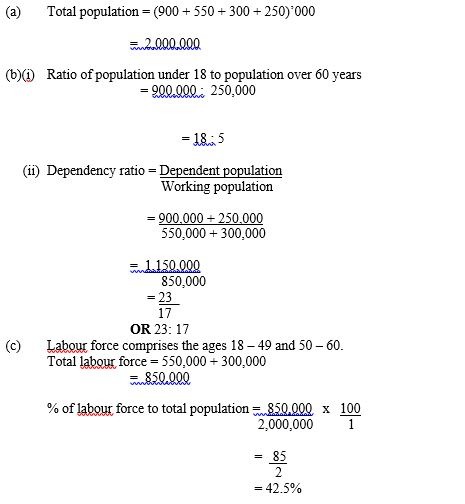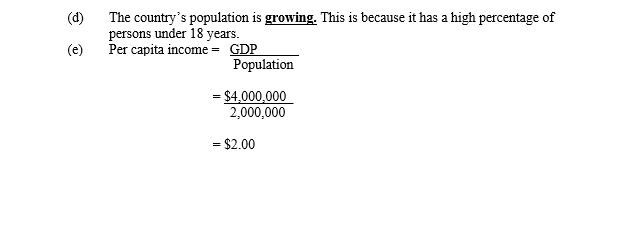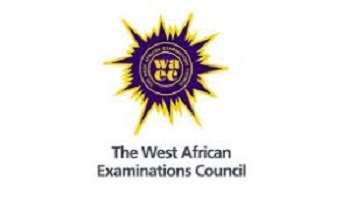Table of Contents
WAEC Economics questions 2020
In this post, we will be giving out the samples of waec economics questions for candidates that will participate in the examination from past questions.
WAEC Economics theory Questions – Answers insight:
PAPER 2 [Essay]
Answer any FIVE questions.
Write your answers on the answer booklet provided.
1. The following data shows the budget of a hypothetical country in 2006. Use the information in the table to answer the questions that follow:
| Age (years) | 0 – 17 | 18 – 49 | 50 – 60 | 60 and above |
| Population (‘000) | 900 | 550 | 300 | 250 |
(a) What is the country’s total population?
(b) Calculate:
(i) the ratio of population under 18 to population over 60 years;
(ii) the dependency ratio.
(c) What percentage of the population constitutes the labour force?
(d) Explain whether the population is growing or declining.
(e) Given that the GDP of the country in 2009 is $ 4,000,000, what is the per capita income of the country?


2. A village consists of twenty (20) households with the following annual incomes:
|
(Incomes N) |
||||
|
30 |
20 |
50 |
40 |
60 |
|
40 |
40 |
50 |
20 |
60 |
|
80 |
40 |
20 |
20 |
70 |
|
40 |
70 |
30 |
40 |
80 |
(a) Determine the (i) mean income;
(ii) modal income;
(iii) median income.
(b) What is the range of the income distribution?
(c) Calculate the total tax that could be generated from the village if
(i) a flat rate tax of 7% is imposed on all households;
(ii) a flat rate tax of 15% is imposed on all households earning N4,000 per annum and above.
3. (a) Why is scarcity a fundamental problem in Economics?
(b) Give a reason why Economics is a;
(i) Science;
(ii) Social Science.
ANS: (a) Economics seeks to study the relationship between ends and means. Ends are unlimited while the means are limited. Scarcity means resources are limited in relation to the ends. Economics is therefore concerned with allocating the limited resources among the competing and unlimited wants.
(b) (i) Economics is a science because it adopts the scientific method.
(ii) Economics is a social science because it studies human behaviour. e.g. If the price of a commodity rises, people will buy less, other things equal.
4. (a) Outline the chain of distribution for manufactured consumer goods.
(b) Explain the functions of the
(i) wholesaler;
(ii) retailer.
5. (a) Define labour.
(b) Give four factors that affect the efficiency of labour in your country.
ANS: (b) (i) Education and Training: All kinds of labour require training which may include formal training, training on the job.
(ii) Availability of equipment and tools: Labour efficiency also depends on the equipment and tools available to workers.
(iii) Physical Environment: The environment in which labour works helps to determine its efficiency as well as its productivity e.g. harsh physical environment.
(iv) Human environment – conducive management style will increase labour efficiency.
6. (a) Define money.
(b) State the three motives for holding money.
(c) Mention two determinants of each of the motives for holding money.
ANS: Transactions motive
(i) size of income;
(ii) interval between wage payments;
(iii) availability of credit;
(iv) family size.
Precautionary motive
(i) size of income;
(ii) interval between wage payments;
(iii) availability of credit;
(iv) perception of risks.
Speculative motive
(i) the rate of interest;
(ii) the degree of risk aversion.
7. (a) With the aid of a diagram, explain a minimum price.
(b) State any five measures by which a minimum price for an agricultural produce can be made effective.
8. (a) What is a supply schedule?
(b) Using an example, show how a market supply schedule of a product is obtained from individual supply schedules.
(c) State three examples of exceptional demand.
ANS: (c) Exceptional demand:
i. Fixed demand or perfectly inelastic demand e.g. salt
ii. Perfectly elastic demand
iii. Expectation of future increase in price.
iv. Articles of ostentation.
v. Giffen goods.
9. (a) With examples, distinguish between direct and indirect tax.
(b) Explain any four problems of tax collection in any West African Country.
ANS: (a) A direct tax is a tax on incomes and properties. Examples include persona income tax, company tax, death duties, inheritance tax, capital gains taxes, etc.
Whereas, an indirect tax is tax on goods and services. Examples include sales tax, import and export duties, excise tax, purchase tax, value added tax, etc.
(b) (i) absence of reliable records of business activities and revenues collected.
(ii) the prevalence of subsistence production.
(iii) corruption on the part of tax officials.
(iv) high level of tax evasion and tax avoidance etc.
10. (a) What is demographic transition theory ?
(b) Explain the three stages of the theory.
ANS: (a) Demographic Transition Theory is concerned with the historical population growth of society. It explains the relationship between fertility and mortality on population growth and how developed countries in contemporary times have passed through three identical stages of population history.
(b) Stages of the Theory;
stage 1 (pre-transition phase/ stage)
stage 2 (transition phase/ stage)
stage 3 (post transition phase /stage)
11. (a) Differentiate between shares and debentures.
(b) Identify any four problems encountered by farmers in raising capital
ANS: (a) A share is the smallest unit into which the capital of a company is divided. It is a unit of ownership of a business concern while a debenture is a loan capital or corporate bond. A debenture holder is a creditor to a company.
(b) (i) low level of loanable funds;
(ii) inability of firms to produce the required collateral facilities;
(iii) under-developed money and capital markets;
(iv) high cost of loans;
(v) fluctuation of share prices;
(vi) Government financial regulation.
12. (a) What is a capital market?
(b) Describe any three instruments used in the capital market.
ANS: (a) The capital market is a financial market in which funds for medium and long term investments are borrowed or lent.
(b) (i) Shares: These are financial instruments utilized in the capital market for long term investments. A share is the portion of a limited liability company owned by an investor.
(ii) Bonds: This is a long term financial security used to source for funds. Bonds may be issued by firms, financial institutions or governments. Bonds issued by the government are generally regarded as very safe.
(iii) Treasury certificates: These are government financial securities which mature after a year. They are issued by the government through the central bank to either borrow or lend money in the capital market.


where are the rest of the answers?